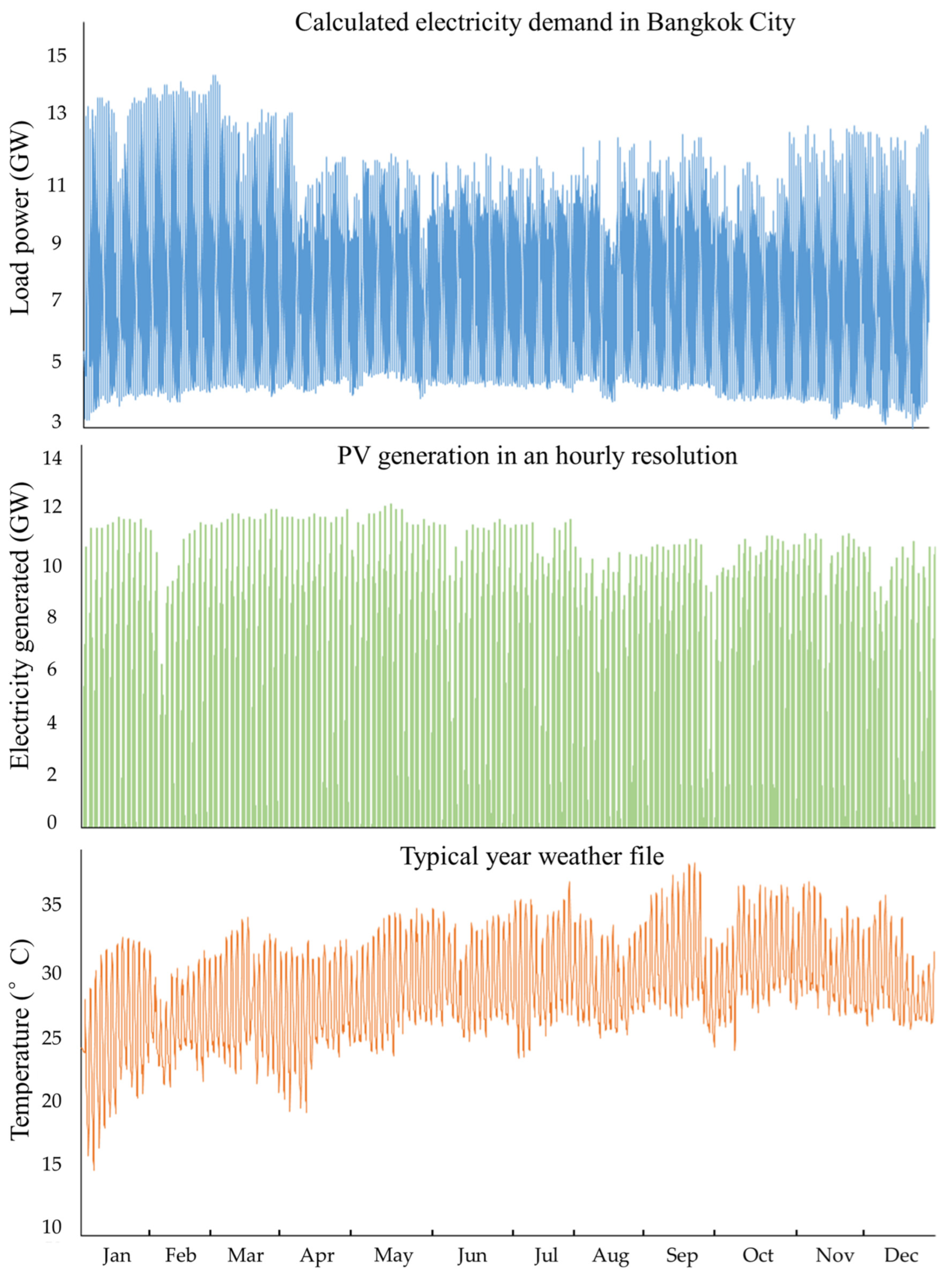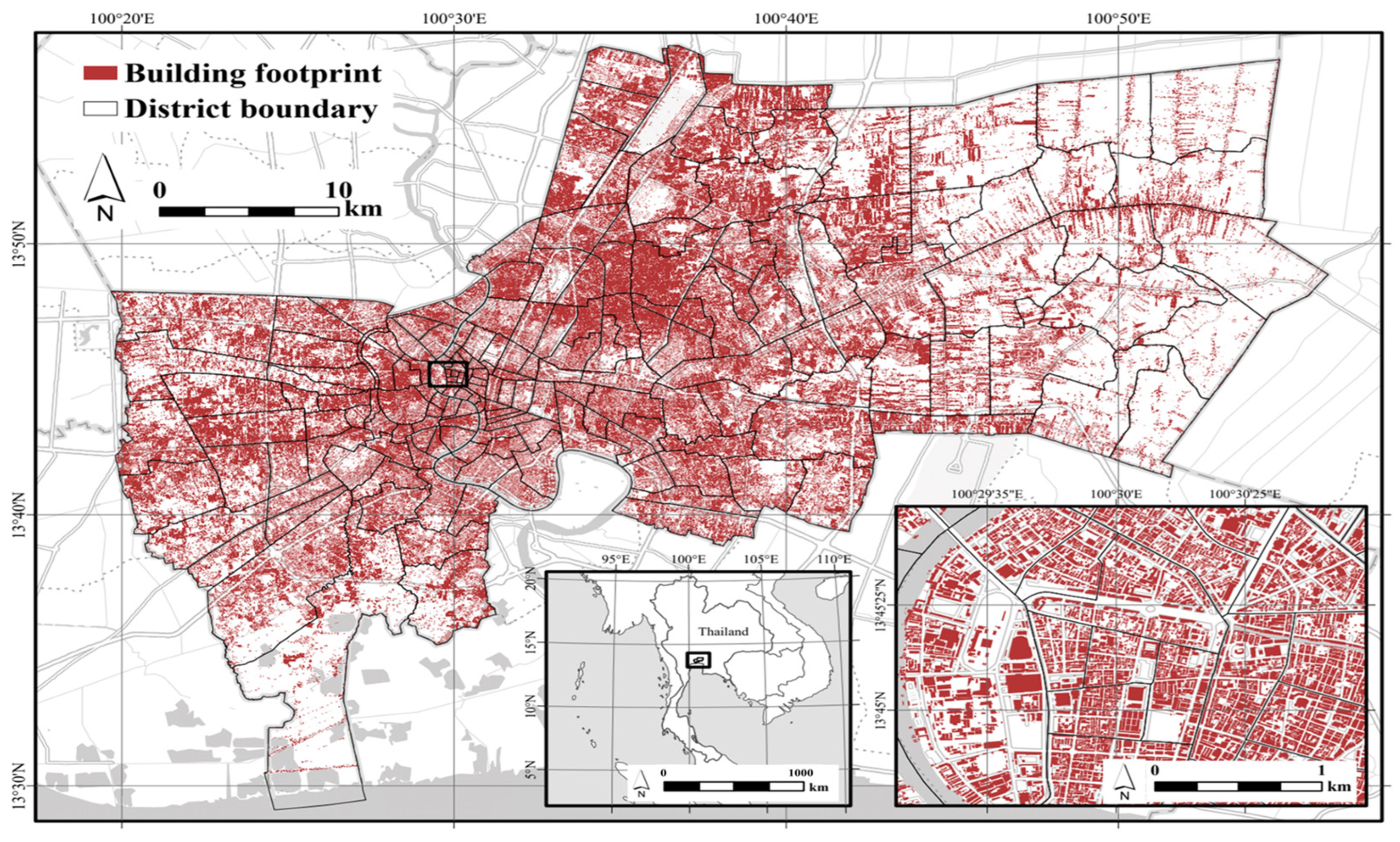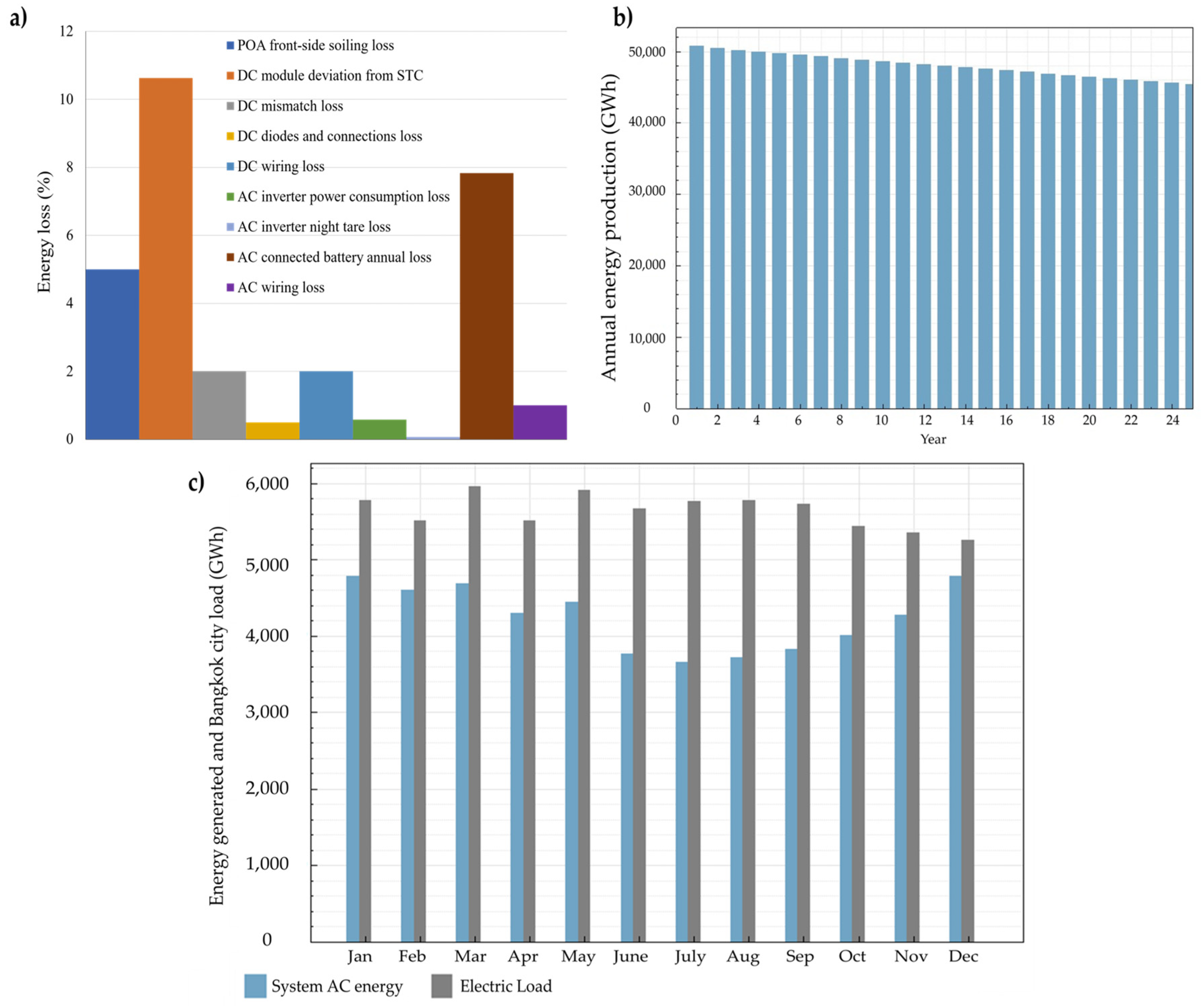On the Adoption of Rooftop Photovoltaics Integrated with Electric Vehicles toward Sustainable Bangkok City, Thailand
Abstract
1. Introduction
2. EVs in Thailand: A Key Development and Decarbonization Strategy
3. Methodology
3.1. Techno-Economic Analysis
3.2. Data and Parameters Utilized in the Assessment of SAM
3.3. Rooftop Area and Maximum PV Capacity
3.4. System Cost and Operation
3.5. Electricity Demand and Tariffs
4. Result
4.1. Scenarios
4.2. Techno-Economic Assessments
4.3. Impacts of FITs on Decarbonization Potential
4.4. Sensitivity Analysis
5. Discussion
5.1. Deep Decarbonization of Bangkok City Using Rooftop PV and EVs
5.2. Decarbonization Comparison between Bangkok and Kyoto Cities
5.3. Policy Implications for Bangkok City
5.4. Limitations of the Study
6. Conclusions
Supplementary Materials
Author Contributions
Funding
Data Availability Statement
Conflicts of Interest
Nomenclature
| PV | Photovoltaic |
| SAM | System Advisor Model |
| FIT | Feed-in-tariff |
| EV | Electric vehicle |
| BEV | Battery electric vehicle |
| DoD | Depth of discharge |
| NPV | Net present value |
| SOC | State of charge |
| V2H | Vehicle to Home |
| V2B | Vehicle to Building |
| ICE | Internal combustion engine |
| ICT | Information and Communication Technology |
| VPP | Virtual power plant |
References
- IPCC Climate Change 2022: Impacts, Adaptation, and Vulnerability. Contribution of Working Group II to the Sixth Assessment Report of the Intergovernmental Panel on Climate Change. 2022. Available online: https://www.ipcc.ch/report/ar6/wg2/ (accessed on 10 February 2023).
- IPCC Climate Change 2022: Mitigation of Climate Change. Contribution of Working Group III to the Sixth Assessment Report of the Intergovernmental Panel on Climate Change. 2022. Available online: https://www.ipcc.ch/report/ar6/wg3/ (accessed on 10 February 2023).
- IPCC Climate Change 2021: The Physical Science Basis. Contribution of Working Group I to the Sixth Assessment Report of the Intergovernmental Panel on Climate Change. 2021. Available online: https://www.ipcc.ch/report/ar6/wg1/ (accessed on 10 February 2023).
- Jackson, R.B.; Le Quéré, C.; Andrew, R.M.; Canadell, J.G.; Korsbakken, J.I.; Liu, Z.; Peters, G.P.; Zheng, B. Global energy growth is outpacing decarbonization. Environ. Res. Lett. 2018, 13, 120401. [Google Scholar] [CrossRef]
- Echeverri, L.G. Investing for rapid decarbonization in cities. Curr. Opin. Environ. Sustain. 2018, 30, 42–51. [Google Scholar] [CrossRef]
- IRNEA. Renewable Power Generation Costs in 2021; IRENA: Masdar City, United Arab Emirates, 2022; ISBN 978-92-9260-244-4. [Google Scholar]
- Vanegas Cantarero, M.M. Of renewable energy, energy democracy, and sustainable development: A roadmap to accelerate the energy transition in developing countries. Energy Res. Soc. Sci. 2020, 70, 101716. [Google Scholar] [CrossRef]
- Gumilang, R.; Welo, U.; Siagian, R.; Asmara, B.; Dyah, S.; Ichihara, J.; Kobashi, T. Equitable, affordable, and deep decarbonization pathways for low-latitude developing cities by rooftop photovoltaics integrated with electric vehicles. Appl. Energy 2023, 332, 120507. [Google Scholar] [CrossRef]
- Di Silvestre, M.L.; Favuzza, S.; Riva Sanseverino, E.; Zizzo, G. How Decarbonization, Digitalization and Decentralization are changing key power infrastructures. Renew. Sustain. Energy Rev. 2018, 93, 483–498. [Google Scholar] [CrossRef]
- IEA. World Energy Outlook 2022; IEA: Vienna, Austria, 2022. [Google Scholar]
- Kobashi, T.; Choi, Y.; Hirano, Y.; Yamagata, Y.; Say, K. Rapid rise of decarbonization potentials of photovoltaics plus electric vehicles in residential houses over commercial districts. Appl. Energy 2022, 306, 118142. [Google Scholar] [CrossRef]
- Chang, S.; Cho, J.; Heo, J.; Kang, J.; Kobashi, T. Energy infrastructure transitions with PV and EV combined systems using techno-economic analyses for decarbonization in cities ☆. Appl. Energy 2022, 319, 119254. [Google Scholar] [CrossRef]
- Kobashi, T.; Jittrapirom, P.; Yoshida, T.; Hirano, Y.; Yamagata, Y. SolarEV City concept: Building the next urban power and mobility systems. Environ. Res. Lett. 2021, 16, 024042. [Google Scholar] [CrossRef]
- Kobashi, T.; Yoshida, T.; Yamagata, Y.; Naito, K.; Pfenninger, S.; Say, K.; Takeda, Y.; Ahl, A.; Yarime, M.; Hara, K. On the potential of “Photovoltaics + Electric vehicles” for deep decarbonization of Kyoto’s power systems: Techno-economic-social considerations. Appl. Energy 2020, 275, 115419. [Google Scholar] [CrossRef]
- Liu, J.; Li, M.; Xue, L.; Kobashi, T. A framework to evaluate the energy-environment-economic impacts of developing rooftop photovoltaics integrated with electric vehicles at city level. Renew. Energy 2022, 200, 647–657. [Google Scholar] [CrossRef]
- United Nations Framework Convention on Climate Change (UNFCCC). Mid-Century, Long-Term Low Greenhouse Gas Emission Development Strategy. 2021. Available online: https://unfccc.int/sites/default/files/resource/Thailand_LTS1.pdf. (accessed on 13 September 2022).
- World Bank. GDP per Capita, PPP—Thailand. Available online: https://data.worldbank.org/indicator/NY.GDP.PCAP.PP.CD?locations=TH (accessed on 1 February 2023).
- Chandler, M.H.M. Thailand’s First Climate Change Bill to be Submitted for Approval. 2022. Available online: https://www.lexology.com/account/login?ReturnUrl=%2flibrary%2fdetail.aspx%3fg%3d07c23552-5798-47d4-b986-0dbc96690c9f (accessed on 11 September 2022).
- Solargis. Solar Resource Maps of Asia. Available online: https://solargis.com/maps-and-gis-data/download/asia (accessed on 1 February 2023).
- Junlakarn, S.; Kittner, N.; Tongsopit, S.; Saelim, S. A cross-country comparison of compensation mechanisms for distributed photovoltaics in the Philippines, Thailand, and Vietnam. Renew. Sustain. Energy Rev. 2021, 145, 110820. [Google Scholar] [CrossRef]
- Sagulpongmalee, K.; Therdyothin, A.; Nathakaranakule, A. Analysis of feed-in tariff models for photovoltaic systems in Thailand: An evidence-based approach. J. Renew. Sustain. Energy 2019, 11, 045903. [Google Scholar] [CrossRef]
- Silva, K.; Janta, P.; Chollacoop, N. Points of Consideration on Climate Adaptation of Solar Power Plants in Thailand: How Climate Change Affects Site Selection, Construction and Operation. Energies 2022, 15, 171. [Google Scholar] [CrossRef]
- Khamchiangta, D.; Yamagata, Y. Mapping urban carbon emissions in relation to local climate zones: Case of the building sector in Bangkok Metropolitan Administration, Thailand. Energy Built Environ. 2022. [Google Scholar] [CrossRef]
- Department of Land and Transport (DLT). Transport Statistics Report 2020. 2020. Available online: https://web.dlt.go.th/statistics/load_file_select.php?tmp=1978.031081990883&data_file=1190 (accessed on 11 September 2022).
- Farrow, A.; Anhauser, A.; Moun-Ob, A. The Burden of Air Pollution in Thailand 2021 The Burden of Air Pollution in Thailand 2021. 2022. Available online: https://www.greenpeace.org/static/planet4-southeastasia-stateless/2022/06/67375e28-the-burden-of-air-pollution-in-thailand_2021.pdf (accessed on 11 September 2022).
- OICA. 2021 Production Statistics. Available online: https://www.oica.net/category/production-statistics/2021-statistics/ (accessed on 1 February 2023).
- The Nation Thailand Government Pushing for Thailand’s Emergence as EV Hub in Asean. Available online: https://www.nationthailand.com/thailand/general/40022681 (accessed on 7 February 2023).
- Marklines Thailand: EV Promotion, Subsidy, etc. Available online: https://www.marklines.com/ja/report/rep2401_202212 (accessed on 7 February 2023).
- The Nation Thailand EV. Available online: https://www.nationthailand.com/special-edition/ev/40023978 (accessed on 8 February 2023).
- Marklines Automotive Sales in Thailand 2022. Available online: https://www.marklines.com/ja/statistics/flash_sales/automotive-sales-in-thailand-by-month (accessed on 8 February 2023).
- International Energy Agency. Global EV Outlook 2022 Securing Supplies for an Electric Future; OECD Publishing: Paris, France, 2022. [Google Scholar]
- Kaewpasuk, S.; Intiyot, B.; Jeenanunta, C. Impact of Electric Vehicles and Solar PV on Future Thailand’s Electricity Daily Demand. Int. Sci. J. Eng. Technol. (ISJET) 2020, 4, 21–33. [Google Scholar]
- Kikusato, H.; Mori, K.; Yoshizawa, S.; Fujimoto, Y.; Asano, H.; Hayashi, Y.; Kawashima, A.; Inagaki, S.; Suzuki, T. Electric Vehicle Charge-Discharge Management for Utilization of Photovoltaic by Coordination between Home and Grid Energy Management Systems. IEEE Trans. Smart Grid 2019, 10, 3186–3197. [Google Scholar] [CrossRef]
- Tan, K.M.; Ramachandaramurthy, V.K.; Yong, J.Y. Integration of electric vehicles in smart grid: A review on vehicle to grid technologies and optimization techniques. Renew. Sustain. Energy Rev. 2016, 53, 720–732. [Google Scholar] [CrossRef]
- Chen, J.; Zhang, Y.; Li, X.; Sun, B.; Liao, Q.; Tao, Y.; Wang, Z. Strategic integration of vehicle-to-home system with home distributed photovoltaic power generation in Shanghai. Appl. Energy 2020, 263, 114603. [Google Scholar] [CrossRef]
- Furuya, K. V2H system and energy management. In Urban Decarbonization; Kobashi, T., Ed.; Taiga Publishing: Tokyo, Japan, 2021. (in press)
- Fan, S.; Liu, J.; Wu, Q.; Cui, M.; Zhou, H.; He, G. Optimal coordination of virtual power plant with photovoltaics and electric vehicles: A temporally coupled distributed online algorithm. Appl. Energy 2020, 277, 115583. [Google Scholar] [CrossRef]
- National Renewable Energy Laboratory (NREL). System Advisor Model (SAM). 2021. Available online: https://sam.nrel.gov/ (accessed on 22 April 2022).
- Blair, N.; Diorio, N.; Freeman, J.; Gilman, P.; Janzou, S.; Neises, T.W.; Wagner, M.J. System Advisor Model (SAM) General Description. 2018. Available online: https://www.nrel.gov/docs/fy18osti/70414.pdf (accessed on 22 April 2022).
- Kobashi, T.; Yamagata, Y. Techno-economic assessment on PV systems integrated with batteries and electric vehicles in residential area and urban district in Japan. In Proceedings of the International Conference on Applied Energy 2020, Virtual, 1–10 December 2020. [Google Scholar] [CrossRef]
- Takahashi, K.; Louhisuo, M. IGES List of Grid Emission Factors; Institute for Global Environmental Strategies: Hayama, Japan, 2022. [Google Scholar] [CrossRef]
- European Commission. Photovoltaic Geographical Information System. 2022. Available online: https://re.jrc.ec.europa.eu/pvg_tools/en/ (accessed on 16 June 2022).
- Energy Policy and Planning Office (EPPO). Energy Statistic: Electricity. 2021. Available online: http://www.eppo.go.th/index.php/en/en-energystatistics/electricity-statistic (accessed on 17 August 2022).
- Department of Land and Transport (DLT). Total Vehicle Registration Data. 2019. Available online: http://www.dlt.go.th/minisite/m_upload/m_download/singburi/file_7cf81db11863f882ac1e6814fbb16c02.pdf (accessed on 30 June 2022).
- Metropolitan Electricity Authority (MEA). Statistic Data on Electricity Consumption in 2021. 2021. Available online: https://www.mea.or.th/ (accessed on 30 June 2022).
- Bangkok Metropolitan Administration (BMA). The Residential Area Statistic Report in 2018. 2019. Available online: https://webportal.bangkok.go.th/upload/user/00000354/plan/report/07.pdf (accessed on 11 September 2022).
- Microsoft. Building Footprint Data. 2021. Available online: https://github.com/microsoft/GlobalMLBuildingFootprints (accessed on 4 November 2022).
- Trading Economics. Thailand Gasoline Prices. 2022. Available online: https://tradingeconomics.com/thailand/gasoline-prices (accessed on 22 September 2022).
- Phonrattanasak, P.; Nopbhorn, L. Development of Fast Charging Station for Thailand. Int. J. Innov. Manag. Technol. 2014, 3, 668–674. [Google Scholar]
- Zhang, R.; Zhang, J.; Long, Y.; Wu, W.; Liu, J.; Jiang, Y. Long-term implications of electric vehicle penetration in urban decarbonization scenarios: An integrated land use–transport–energy model. Sustain. Cities Soc. 2021, 68, 102800. [Google Scholar] [CrossRef]
- Nissan Motor Inc. Nissan Begins Testing Energy Supply Demand Management System Using LEAF EVs and “LEAF to Home” Power System. 2014. Available online: https://www.nissanglobal.com/EN/NEWS/2014/_STORY/141016-02-e.html (accessed on 16 September 2022).
- IRENA. Renewable Power Generation Costs 2020. 2021. Available online: https://www.irena.org/-/media/Files/IRENA/Agency/Publication/2021/Jun/IRENA_Power_Generation_Costs_2020.pdf (accessed on 27 December 2022).
- Energy Policy and Planning Office (EPPO). A FIT Policy for Purchasing Energy Generated from Renewable Sources. 2015. Available online: http://www.eppo.go.th/images/Power/pdf/FT-history/FiT_2558.pdf (accessed on 27 December 2022).
- Diorio, N.; Dobos, A.; Janzou, S.; Nelson, A.; Lundstrom, B. Technoeconomic Modeling of Battery Energy Storage in SAM. Technical Report; National Renewable Energy Laboratory: Golden, CO, USA, 2015. [Google Scholar]
- Department of Alternative Energy Development and Efficiency (DEDE). Solar PV Rooftop (TH). 2014. Available online: https://webkc.dede.go.th/testmax/sites/default/files/kb00_a109_Solar%20PV%20Rooftop%20%28TH%29.pdf (accessed on 10 September 2022).
- CleanTechnica. Just the Facts: The Cost of Solar Has Fallen More Quickly Than Experts Predicted. 2022. Available online: https://cleantechnica.com/2022/06/08/just-the-facts-the-cost-of-solar-has-fallen-more-quickly-than-experts-predicted/#:~:text=For%20more%20than%204%20decades,rate%20near%2010%25%20per%20year (accessed on 10 September 2022).
- International Energy Agency (IEA). National Survey Report of PV Power Applications in Thailand: 2021. 2021. Available online: https://iea-pvps.org/wp-content/uploads/2022/09/NSR-of-PV-Power-Applications-in-Thailand-2021.pdf (accessed on 27 December 2022).
- Ministry of Economy, Trade and Industry (METI). Roadmap for Variable Renewable Energy (VRE): Integration to Power Grid in Thailand. Technical Report. 2018. Available online: https://www.meti.go.jp/meti_lib/report/H30FY/000664.pdf (accessed on 22 April 2022).
- Metropolitan Electricity Authority (MEA). Electricity Rate for Household and Industry. Technical Report. 2021. Available online: https://www.mea.or.th/upload/download/file_0cbe47e5f271ef298469220a52ae00d8.pdf (accessed on 22 April 2022).
- Pongprasert, P.; Kubota, H. Why TOD Residents Still Use Car? Urban Reg. Plan. Rev. 2017, 4, 231–250. [Google Scholar] [CrossRef]
- Japan International Cooperation Agency (JICA). Bangkok Metropolitan Administration’s Initiative Zero Carbon. 2022. Available online: https://www.jica.go.jp/activities/issues/env_manage/jcci/uurjcd000000fdje-att/presentation_15.pdf (accessed on 20 December 2022).
- Department of Local Administration (DLA). Standard for Building Control Administration. 2015. Available online: http://www.dla.go.th/work/e_book/eb1/stan13/stan13.html (accessed on 25 September 2022).
- Weiss, M.; Patel, M.K.; Junginger, M.; Perujo, A.; Bonnel, P.; van Grootveld, G. On the electrification of road transport—Learning rates and price forecasts for hybrid-electric and battery-electric vehicles. Energy Policy 2012, 48, 374–393. [Google Scholar] [CrossRef]
- Weather and Climate. Average Monthly Hours of Sunshine in Kyoto (Kyoto). 2023. Available online: https://weather-and-climate.com/average-monthly-hours-Sunshine,kyoto,Japan (accessed on 22 February 2023).
- Weather and Climate. Average Monthly Hours of Sunshine in Bangkok (Bangkok Province). 2023. Available online: https://weather-and-climate.com/average-monthly-hours-Sunshine,Bangkok,Thailand (accessed on 22 February 2023).
- Suwanmontri, C.; Kawashima, H. Trailing and Projecting the Real Population of Bangkok to 2030. J. Sustain. Dev. 2015, 8, 121. [Google Scholar] [CrossRef]







| Input Parameter | Unit | Value | Source |
|---|---|---|---|
| Latitude, longitude | ° N, ° E | 13.83, 100.62 | [42,45] |
| Elevation | meter | 6 | [42] |
| Tilt | degree | 13.8 | - |
| Azimuth | degree | 180 | - |
| Population | person | 5,666,264 | [46] |
| Rooftop area | km2 | 257.3 | This study and [47] |
| Maximum PV capacity | GW | 36.8 | - |
| PV utilization rate | % | 17.6 | From SAM’s calculation |
| Registered passenger vehicles | car | 5,073,396 | [44] |
| Gasoline price | USD·L | 1.05 | [48], 10-year average |
| Gasoline CO2 emission factor | kgCO2·L | 2.3 | [14] |
| EV efficiency | km·kWh−1 | 5.3 | [14] |
| Annual driving distance | km·yr−1 | 15,633 | Adapted from [49] |
| Items | Units | Costs |
|---|---|---|
| PV maintenance cost in 2020 1,2 | USD·kW−1·yr−1 | 9.18 |
| PV maintenance cost in 2030 1,2,3 | USD·kW−1·yr−1 | 3.20 |
| Rooftop PV system in 2020 1 | USD·W−1 | 1.35 |
| Rooftop PV system in 2030 1,2,3 | USD·W−1 | 0.47 |
| EV additional cost in 2030 4 | USD·kWh−1 | 22 |
| EV battery replacement cost in 2030 4 | USD·kWh−1 | 91 |
| Yearly Electricity Consumption | Tariffs | FITs | |
|---|---|---|---|
| (TWh) | (USD/kWh) | (USD/kWh) | |
| Household (0–10 kW) | 15.3 | 0.13 | 0.06 |
| Small business (10–250 kW) | 0.14 | 0.03 | |
| Medium–large business (250–1000 kW) | 35.4 | 0.15 | 0.03 |
| Total or weighted | 50.7 | 0.14 | 0.04 |
| Scenario | Technologies | Year | FITs |
|---|---|---|---|
| A | Rooftop PV | 2020 | Applied |
| B | Rooftop PV | 2020 | Not applied |
| C | Rooftop PV | 2030 | Applied |
| D | Rooftop PV | 2030 | Not applied |
| E | Rooftop PV + EV | 2030 | Applied |
| F | Rooftop PV + EV | 2030 | Not applied |
| With FIT | Without FIT | |||
|---|---|---|---|---|
| 2020 | PV Only | PV + EV | PV Only | PV + EV |
| Optimal PV capacity (GW) | 22.1 | N/A | 14.4 | N/A |
| NPV over project period (USD B) | 26.6 | N/A | 23.3 | N/A |
| Discounted Payback Period (yr) | 10.3 | N/A | 8.7 | N/A |
| Cost Saving (%) | 8 | N/A | 7 | N/A |
| CO2 Emission Reduction (%) | 28 | N/A | 24 | N/A |
| Self-consumption (%) | 64 | N/A | 86 | N/A |
| Self-sufficiency (%) | 42 | N/A | 36 | N/A |
| Energy sufficiency (%) | 65 | N/A | 42 | N/A |
| 2030 | ||||
| Optimal PV capacity (GW) | 36.8 | 36.8 | 24.7 | 36.8 |
| NPV over project period (USD B) | 59.9 | 94.0 | 41.1 | 94.0 |
| Discounted payback period (yr) | 4.0 | 3.2 | 4.0 | 3.2 |
| Cost savings (%) | 19 | 59 | 13 | 59 |
| CO2 emission reduction (%) | 32 | 73 | 29 | 73 |
| Self-consumption (%) | 43 | 95 | 59 | 95 |
| Self-sufficiency (%) | 46 | 71 | 43 | 71 |
| Energy sufficiency (%) | 109 | 75 | 73 | 75 |
Disclaimer/Publisher’s Note: The statements, opinions and data contained in all publications are solely those of the individual author(s) and contributor(s) and not of MDPI and/or the editor(s). MDPI and/or the editor(s) disclaim responsibility for any injury to people or property resulting from any ideas, methods, instructions or products referred to in the content. |
© 2023 by the authors. Licensee MDPI, Basel, Switzerland. This article is an open access article distributed under the terms and conditions of the Creative Commons Attribution (CC BY) license (https://creativecommons.org/licenses/by/4.0/).
Share and Cite
Jittayasotorn, T.; Sadidah, M.; Yoshida, T.; Kobashi, T. On the Adoption of Rooftop Photovoltaics Integrated with Electric Vehicles toward Sustainable Bangkok City, Thailand. Energies 2023, 16, 3011. https://doi.org/10.3390/en16073011
Jittayasotorn T, Sadidah M, Yoshida T, Kobashi T. On the Adoption of Rooftop Photovoltaics Integrated with Electric Vehicles toward Sustainable Bangkok City, Thailand. Energies. 2023; 16(7):3011. https://doi.org/10.3390/en16073011
Chicago/Turabian StyleJittayasotorn, Thiti, Muthiah Sadidah, Takahiro Yoshida, and Takuro Kobashi. 2023. "On the Adoption of Rooftop Photovoltaics Integrated with Electric Vehicles toward Sustainable Bangkok City, Thailand" Energies 16, no. 7: 3011. https://doi.org/10.3390/en16073011
APA StyleJittayasotorn, T., Sadidah, M., Yoshida, T., & Kobashi, T. (2023). On the Adoption of Rooftop Photovoltaics Integrated with Electric Vehicles toward Sustainable Bangkok City, Thailand. Energies, 16(7), 3011. https://doi.org/10.3390/en16073011






